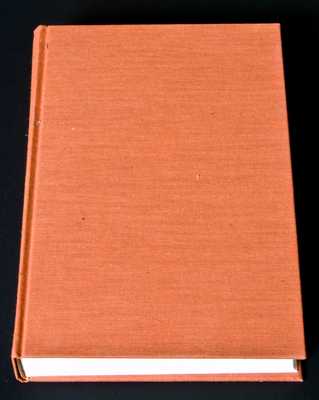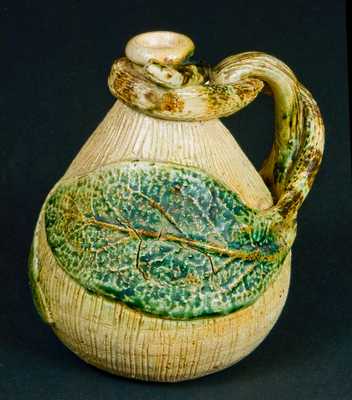Exceedingly Rare and Important Stoneware Pitcher with Double Applied Eagle Decoration and Brushed Cobalt Star and Foliate Motif, Stamped Twice "WM. PORTER," Pleasantville, Venango County, PA, circa 1830, approximately two-gallon, highly ovoid pitcher with short collar, large molded pouring spout, and applied strap handle with upswept terminal. Decorated with a large molded and cobalt-highlighted eagle on both sides, below the maker's mark "WM. PORTER," which is flanked by brushed cobalt stars on each side. Eagle is underscored by dramatic cobalt brushwork representing leaves or a flower blossom. Collar and handle profusely decorated with cobalt swags and spout decorated with vertical stripes of cobalt. The potter, William Porter, learned his trade at the shop of his father, Micah, in Rochester, NY. Around the year 1823, William moved to Pleasantville, then called Benedictown, in Venango County, PA. The founder of the town, Aaron Benedict, had enticed the potter into moving there after telling him of the large local clay deposits. Porter later married Benedict's daughter, and his family would produce pottery in Western Pennsylvania for the next several decades. Interestingly, one of Pennsylvania's first oil wells was discovered on William Porter's farm (Ketchum, American Stoneware, p. 93). This pitcher has an exceptional form, clearly influenced by British creamware of the late 18th and early to mid 19th centuries. It closely resembles a small number of important pitchers made circa 1840 at the Henry Lowndes pottery in Petersburg, VA. Lowndes had no doubt learned this style from his English roots. As a child, he had immigrated to Virginia from Staffordshire, England, and his father, Thomas, who was also a potter, had almost certainly learned the trade there. Similarly, the Porter pitcher was likely made or influenced by British-trained potters who immigrated to America. According to various written histories of Pleasantville and Venango County, the Porter pottery was most well known for its high quality Rockingham and Liverpool Queensware, and the business actually hired Scottish potters to produce such items. It is likely that one of these men had a hand in making this pitcher. One of the most important recent discoveries in American stoneware. Near mint condition with a minor base chip and base nick. A few salt drips to reverse. H 12 1/2".









